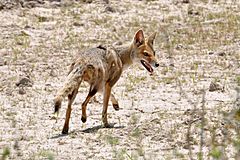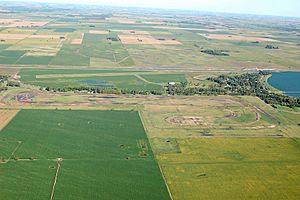Pampas facts for kids
Quick facts for kids
Pampas
|
|
|---|---|
|
Natural region
|
|
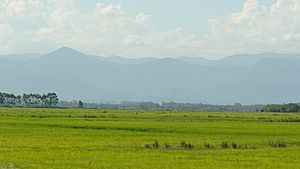
Landscape in the Pampas at eye level. Brazil.
|
|
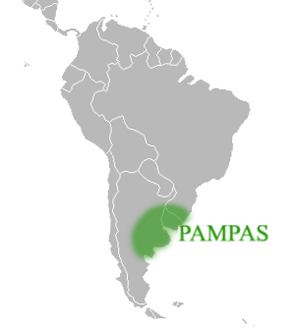
Approximate location and borders of the Pampas encompassing the southeastern area of South America bordering the Atlantic Ocean
|
|
| Countries | |
| Elevation | 160 m (520 ft) |
| Population | |
| • Total | 35,000,000 |
The Pampas are large, flat South American lowlands. The name "Pampas" comes from a Quechua word. It simply means "plain." This huge area covers more than 750,000 square kilometers (290,000 sq mi).
The Pampas stretch across parts of Argentina, most of Uruguay, and the southern part of Brazil. The weather here is generally mild. About 35 million people live in this natural region.
Contents
Amazing Animals of the Pampas
The Pampas are home to many different animals. Some animals eat only plants. These are called herbivores. Examples include the pampas deer, guanaco, and Brazilian guinea pig. You might also spot the plains viscacha or the coypu.
Other animals are predators. They hunt other animals for food. The biggest predator is the puma. Smaller predators include the maned wolf and pampas fox. The geoffroy's cat and lesser grison also live here. Some animals, like the white-eared opossum, eat both plants and animals.
Many bird species also live in the Pampas. Look for the ruddy-headed goose and the pampas meadowlark. Large birds like the maguari stork and the rhea roam the plains. You might also see the southern screamer or the burrowing owl.
Plants and Landscapes
Wildfires happen often in the Pampas. These fires help small plants like grasses grow well. Because of this, large trees are not very common. The main plants you will see are different types of grasses. Many species of the grass Stipa are very noticeable.
A famous plant from this area is "Pampas grass" (Cortaderia selloana). It is a well-known symbol of the Pampas. The plants here are usually perennial grasses and herbs. Different kinds of grasses grow depending on how much water is available.
Different Pampas Regions
The World Wildlife Fund divides the Pampas into three main ecoregions. These are areas with similar plants and animals.
- The Uruguayan Savanna is to the east of the Paraná River. It covers all of Uruguay. It also includes parts of Argentina's Entre Ríos and Corrientes provinces. The southern part of Brazil's Rio Grande do Sul state is also in this region.
- The Humid Pampas covers eastern Buenos Aires Province in Argentina. It also includes the southern part of Entre Ríos Province.
- The Semiarid Pampas is in western Buenos Aires Province. It also includes nearby parts of Santa Fe, Córdoba, and La Pampa provinces.
The Pampas are surrounded by drier grasslands called the Argentine espinal. This area forms a curve around the Humid Pampas.
Climate and Farming
Winters in the Pampas are cool or mild. Summers are very warm and humid. Rain falls fairly evenly throughout the year. However, it rains a bit more during the summer months. More rain falls near the coast and less further inland.
Summer rain often comes as short, heavy showers and thunderstorms. Other times of the year, rain comes from cold fronts. Even though winter nights can be freezing, snow is rare. Light snow might fall a few times in inland areas during most winters.
Central Argentina is a very successful farming area. Many crops are grown on the Pampas, especially south and west of Buenos Aires. This region is also used for raising cattle. More recently, vineyards have started to grow grapes for wine in the Buenos Aires wine region. These farming areas can sometimes get flooded during heavy thunderstorms. The average temperature in the Pampas is about 16 degrees Celsius (60 degrees Fahrenheit) all year.
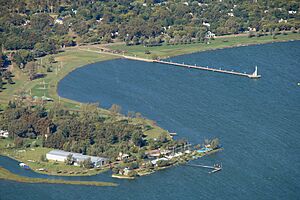
Images for kids
See also
 In Spanish: Pampa (geobotánica) para niños
In Spanish: Pampa (geobotánica) para niños



